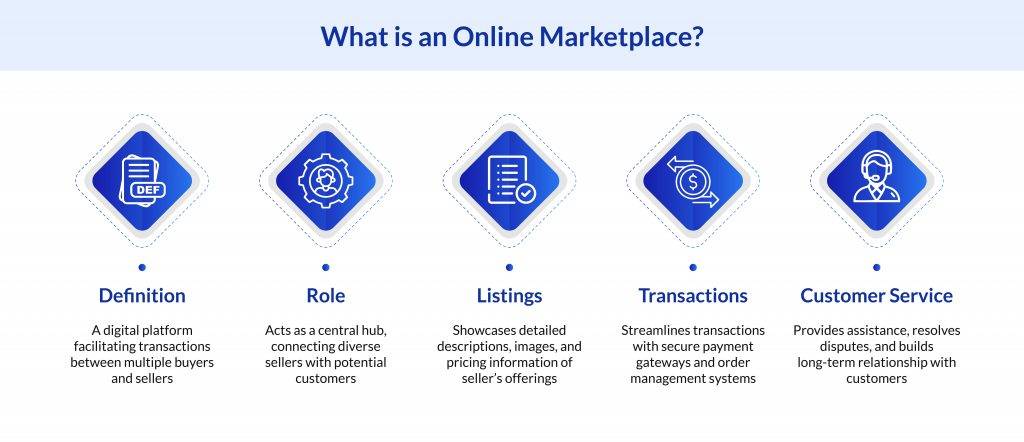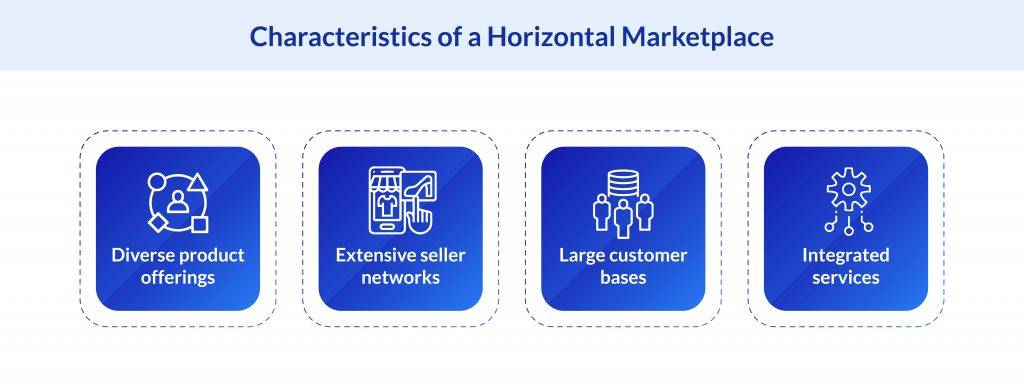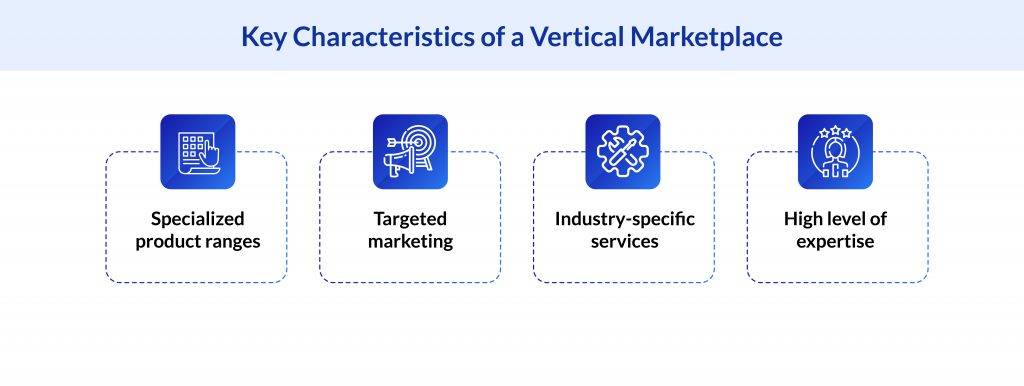According to a study by eMarketer, the e-commerce industry is positioned for significant growth, with total retail spending expected to touch almost $8 trillion by 2027. At the center of this boom are online marketplaces like Flipkart and Walmart, which have become the preferred choice for millions of consumers and sellers alike.
These platforms facilitate a seamless connection between buyers and sellers, simplifying transactions. However, not all online marketplaces are the same. In fact, there are two distinct types of marketplaces: vertical and horizontal, each catering to specific customer needs. By knowing everything about both these options, you can navigate the e-commerce landscape effectively and select the best marketplace model for your company.
This blog explores the essential aspects of both these marketplaces, including their key features, benefits, challenges, and how they compare. Read on to learn more.
What is an Online Marketplace?
An online marketplace is a digital platform that facilitates transactions between multiple buyers and sellers, transforming the way these parties interact online. These platforms act as central hubs, connecting a diverse network of sellers with a vast audience of potential customers, enabling seamless transactions and powering a thriving ecommerce ecosystem.
The core components of an online marketplace business model include product listings, where sellers showcase their offerings to potential buyers. These listings feature detailed descriptions, images, and pricing information that assist customers with making informed purchasing decisions. Streamlined transaction facilitation with payment gateways and order management systems is another important feature of an online marketplace for a hassle-free user experience.
Similarly, Customer support ensures that both buyers and sellers have access to assistance when needed. From resolving disputes to providing guidance on product usage and returns, effective customer support is essential for building trust and creating long-term relationships between marketplace participants.
Examples of successful online marketplaces include Flipkart, a prominent ecommerce marketplace in India that offers an extensive range of products across various departments, and eBay, a global marketplace known for its diverse offerings and unique auction-style selling format.

Understanding Horizontal Marketplaces
A horizontal marketplace is an ecommerce business model that presents a vast range of products and services across multiple groupings. Think of it as a huge online retail mall where you can find everything from electronics to clothing, all under one roof.
A prominent example of a horizontal marketplace is Flipkart, India’s leading ecommerce marketplace. It started as an online book retailer in October 2007 but quickly expanded its product categories to include electronics, fashion, home essentials, and more.
Today, Flipkart is a one-stop shop for over 500 million registered users and 1.4 million sellers with more than 150 million products across 80+ different market segments. In fiscal year 2022-23, Flipkart reported a revenue of over $7 billion, a 7% increase over the previous year.
Key Characteristics of a Horizontal Marketplace

A horizontal marketplace is defined by several key characteristics:
- Diverse product offerings: One of the defining traits of this type of marketplace is its extensive product selection. Whether you are looking for electronics, clothing, or home goods, you will likely find it all in a horizontal marketplace.
- Extensive seller networks: These marketplaces host a large number of sellers, each providing a variety of products. This diversity of sellers ensures that customers have access to a wide array of options, encouraging competition and driving innovation within the marketplace.
- Large customer bases: Thanks to their varied offerings, horizontal marketplaces appeal to a wide audience. As a result, these platforms can achieve economies of scale and drive growth through the potential for increased sales and customer loyalty.
- Integrated services: Horizontal marketplaces are not just about buying and selling various products. They also provide integrated services such as payment gateways, logistics, and customer support, making the shopping experience seamless and convenient
Benefits of Horizontal Marketplaces
As a retailer, you might be wondering why you should consider a horizontal marketplace. Here are some compelling reasons:
- Substantial savings: The horizontal model leverages economies of scale and bulk purchasing. This can lead to lower inventory costs for the marketplace and higher savings for consumers. Hence, you can offer competitive prices to your customers while maintaining healthy profit margins.
- Maximizing profits: This marketplace model offers ample opportunities for cross-selling and upselling. This enables you to maximize profits by presenting complementary products to customers at different stages of their shopping journey. Strategically aligning your products with related offerings from various industries can enhance the average order value and contribute to overall revenue growth.
- A greater market share: With its broad appeal and diverse product offerings, a horizontal marketplace can help expand your reach and visibility among potential customers. With an extensive customer base and multiple marketing channels, you can effectively showcase your products, increasing the chances of making successful sales.
- Good customer engagement: Frequent visits from customers because of the wide selection of products available on such platforms can ensure better customer engagement. By consistently providing a positive shopping experience, you can develop long-term relationships with your buyers, encourage repeat business, and create possible opportunities for referrals.
Challenges of Horizontal Marketplaces
While a horizontal marketplace model offers several benefits, it presents the following set of challenges as well:
- Legal issues: Compliance with diverse regulations across different departments and regions can be complex and time-consuming. You need to ensure that your operations adhere to all relevant laws and standards.
- Acquisition costs: Attracting customers in a horizontal marketplace can be costly, as these platforms often require significant customer acquisition expenses. To stand out in a crowded marketplace, you may need to invest in retail display advertising, promotions, and other marketing initiatives. If not managed effectively, these can adversely impact your profit margins.
- Standardized offerings: Offering personalized services can be challenging due to the varied product categories in a horizontal marketplace. Adapting your offerings and customer support to cater to diverse needs may require additional resources and specialized expertise, which can be a barrier for some retailers.
- Low product differentiation: With so many different products and sellers, standing out in the market can be difficult. To overcome this challenge, focus on providing high-quality products, exceptional customer service, and unique value propositions that set you apart from the competition.
Understanding Vertical Marketplaces
A vertical marketplace is an online platform with specialization in a single market sector or product category. Unlike a horizontal marketplace, which offers a wide range of products across various departments, a vertical market model narrows its focus to cater to a niche audience.
This specialization of vertical models allows for a tailored shopping experience. Examples of vertical marketplaces include Etsy, known for handmade and vintage items; Houzz, dealing in home improvement and design; and StockX, a marketplace for sneaker enthusiasts.
Key Characteristics of a Vertical Marketplace

Vertical marketplaces have several distinctive characteristics that set them apart from horizontal marketplaces:
- Specialized product ranges: A vertical marketplace focuses on a specific product category or industry. This specialization allows for a curated selection of products that cater to a particular audience.
- Targeted marketing: Marketing efforts in a vertical marketplace are aimed at a particular audience segment with specific needs. This targeted approach can drive effective marketing campaigns that resonate with specific customer demographics, driving engagement and conversion rates.
- Industry-specific services: Services in a vertical marketplace are tailored to the needs of a particular industry. This could include specialized payment options, delivery methods, or customer support.
- High level of expertise: Due to their focus on a specific niche, vertical marketplaces often possess in-depth knowledge and expertise in their chosen market. This expertise can translate into high-quality products, knowledgeable customer service, and a shopping experience that meets unique customer needs.
Benefits of Vertical Marketplaces
As a retailer, considering a vertical marketplace for your business can offer several noteworthy advantages:
- Targeted audience engagement: Vertical marketplaces allow you to connect deeply with a specific customer segment. These specialized platforms enable you to foster strong relationships and build brand loyalty through a tailored shopping experience.
- Efficient product discovery: These marketplaces make it easier for customers to discover the products they need, as the offerings are curated and focused on a particular niche. This streamlined product discovery process can lead to higher conversion rates and increased customer satisfaction.
- Elevated quality standards: Because of the focus on a specific type of product, vertical marketplaces often have higher quality control. This attention to quality can differentiate your offerings, build trust with customers, and position your business as a reputed provider in the industry.
- Community-driven insights: Vertical marketplaces also provide valuable community-driven insights, allowing you to leverage feedback and input from a dedicated network of users and sellers. This cooperative approach can help you refine your product offerings, enhance customer service, and stay ahead of industry trends.
Challenges of Vertical Marketplaces
However, vertical marketplaces also come with their own set of challenges that you need to consider:
- Reduced flexibility and responsiveness: A limited product range can make it harder to adapt to market changes. You will need to stay on top of industry trends and be ready to pivot as needed.
- Increased dependency on internal processes: Vertical marketplaces often require a high degree of specialized operations and processes, which can increase the complexity of your internal operations. Navigating such requirements might necessitate additional investments in infrastructure, expertise, and resources, impacting your overall profitability.
- Higher capital requirements: Entering a vertical marketplace may also require higher capital requirements, as you may need to invest in industry-specific infrastructure, technology, and expertise to effectively compete within the niche. This upfront investment can act as a roadblock for some retailers, especially those with limited resources.
- Market saturation and overextension: There is a risk of limited market growth and overextending within a niche market. As these platforms cater to a specific industry or product category, the potential for market growth may be more limited compared to horizontal marketplaces. Carefully evaluating the market dynamics and your ability to differentiate offerings within the niche is crucial to avoid the pitfalls of market saturation.
Differences Between Horizontal and Vertical Marketplaces
Here is a comparative analysis of horizontal and vertical marketplaces:
Criteria | Horizontal Marketplace | Vertical Marketplace |
Definition | An online platform that connects buyers and sellers of a wide variety of products or services across different industries. | An online platform that caters to a specific industry or niche with focus on a particular category of products or services |
Product/Service Range | A vast digital supermarket offering a wide variety of products across multiple departments. | A niche supermarket focusing on a specific category or industry. |
Scope of Market | Targets broad audience with diverse needs. | Caters to a niche market with specialized offerings. |
Depth of Integration | Provides standardized services across all product categories. | Offers specialized services tailored to their specific industry. |
Customer Base | Attracts a wide customer base with varied offerings. | Targets a specific demographic allowing for deeper customer connections. |
Competition Dynamics | Faces broad competition from various sectors. Requires constant innovation and diversification. | Competes within a specific industry, often focusing on quality and specialization to stand out. |
Examples | Flipkart, Walmart, eBay | Etsy, Zillow, Chewy |
Which is the Right Marketplace Model for You?
Choosing the right marketplace model for your business is a strategic decision that should align with your business goals, target audience, and resources. Here is how you should think about it:
Should You Choose a Horizontal Marketplace Model?
If you wish to target a broad audience and offer a wide variety of products across multiple departments, a horizontal marketplace model may be the ideal choice. This model allows you to cater to diverse consumer needs, providing a one-stop-shop experience that appeals to a wide range of customers. Horizontal marketplaces excel in offering extensive product ranges and attracting a large and diverse customer base.
Is the Vertical Marketplace Model Suitable For You?
On the other hand, if your business specializes in a specific industry or product category and aims to provide tailored experiences to a niche audience, a vertical marketplace model could be more suitable. Vertical marketplaces focus on industry domination, offering specialized products and services that serve the particular requirements of a specific demographic. By concentrating on a narrow target group, vertical marketplaces can deliver greater value and establish themselves as experts in their industry.
Choosing the Right Model
When deciding between a horizontal and vertical marketplace model, you must undertake detailed market research, analyze your product range, and assess the competitive landscape. Consider factors such as your business scale, market demand, and growth potential to determine which marketplace model aligns with your strategic objectives.